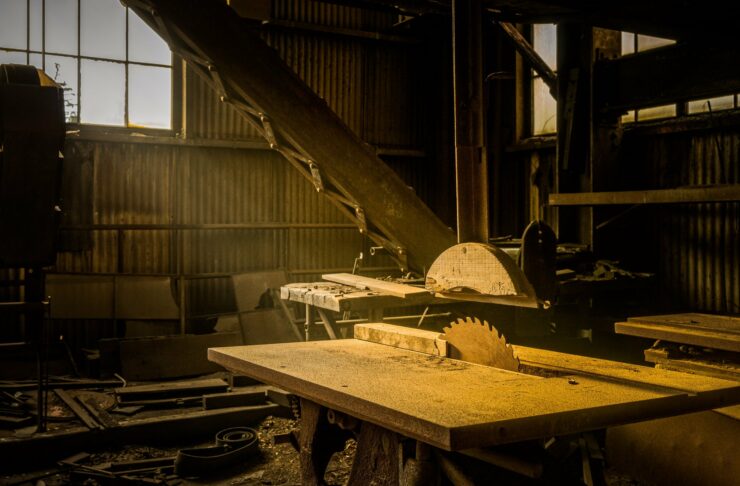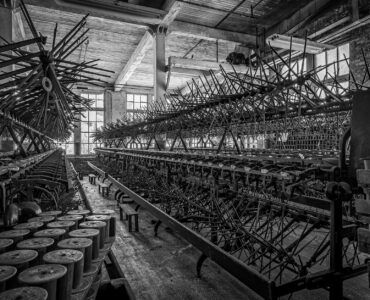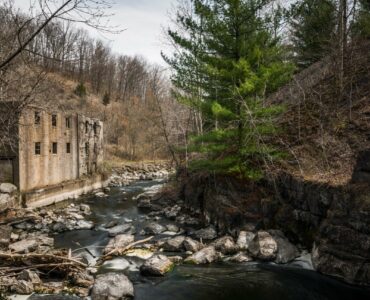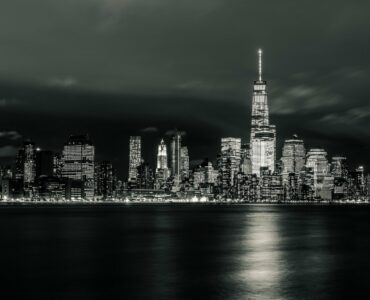I have always had a fascination with the way things work. Since I was a kid, I would constantly take things apart, re-assemble them and try to make them better. Machinery and I just get along real well. Recently on an urban exploration “vacation” with 3 of my friends, a location came up that really got me excited. The “St. Nicholas Coal Breaker” in Pennsylvania. How cool is that right? Still full of old machinery, workman’s boots, control panels, wooden dies for giant machine castings, this really was an industrial playground, and I was super excited.
We received precise entry instructions from a friend and followed them meticulously. Upon arrival, we parked in a designated spot, hoisted our camera backpacks, and ventured in. But it wasn’t easy. The scorching day, with temperatures hitting 98°F, made us sweat profusely. The ground, composed of old slag from the mine, resembled black, sandy, and blistering hot terrain, akin to squishy blacktop that mercifully didn’t stick to our feet.
We trekked about a half-mile down what appeared to be a black dirt road, spotting the colossal breaker in the distance. Standing over 500 yards away, the structure loomed like a towering Goliath, boasting 10 stories of steel and concrete. Cliffs and heaps of slag impeded our progress, prompting us to backtrack and seek an alternative route, despite its imposing presence.
Per Wiki: The Old St. Nicholas Coal Breaker, situated near Mahanoy City, Pennsylvania, was built in 1930 and commenced operations in 1932. To accommodate Reading Anthracite’s colossal Old St. Nicholas Breaker, the world’s largest coal breaker, half of the village of Suffolk had to be relocated. The construction effort involved laying 20 miles (32 km) of railroad track and using 3,800 tons of steel and over 10,000 cubic yards (7,600 m) of concrete.
The breaker was designed with efficiency in mind, featuring a mile and a half of conveyor lines, 25 miles (40 km) of conduit, 26,241 square feet (2,437.9 m) of rubber belting, 118 miles (190 km) of wire and cable, and 20 miles (32 km) of pipe. Divided into two sides, each capable of independent operation, the breaker churned out an impressive 12,500 tons of coal daily.
Once the raw coal entered the production process, it took a mere 12 minutes to traverse the entire breaker. For over three decades, from its inception, the Old St. Nicholas Breaker played a pivotal role in preparing various sizes of renowned Reading Anthracite for global markets.
Okay, are you still with me? Awesome, let’s take a look at this behemoth.



 After going all the way back to the car we ended up parking just up the road an entering right through the front door. Not always the greatest of ideas but on this day, it was. Upon entering the St. Nicholas coal breaker we were greeted a generous blast of cool air which after our trek in the heat was nearly euphoric. Even this paled in comparison to the vision that lay before us. Masses of machinery were rising out of the muck and mud of the ground floor. It certainly looks as though water regularly floods this ground floor level. Hardened mud with animal as well as human tracks everywhere.
After going all the way back to the car we ended up parking just up the road an entering right through the front door. Not always the greatest of ideas but on this day, it was. Upon entering the St. Nicholas coal breaker we were greeted a generous blast of cool air which after our trek in the heat was nearly euphoric. Even this paled in comparison to the vision that lay before us. Masses of machinery were rising out of the muck and mud of the ground floor. It certainly looks as though water regularly floods this ground floor level. Hardened mud with animal as well as human tracks everywhere.

With the ground floor looking just a mess we headed up the stairway and to the second floor. There we found not only more massive machinery but one of the most photographed areas of the breaker, the employees locker room.

 Completely unreal. Every time that I visit a place like this I always have this creepy feeling that someone or something just zapped the people away. They were there in one instance and the next they were vapor. A very intense sense of the human element.
Completely unreal. Every time that I visit a place like this I always have this creepy feeling that someone or something just zapped the people away. They were there in one instance and the next they were vapor. A very intense sense of the human element.
Back down the short steps from the employee area is a pitch-black room with a huge amount of electrical switching units. We could only guess that it was the main power grid, but it was too dark to venture into this time. Besides, there was so much more to explore. In fact, I zipped into another small control room right around the corner and decided to try some shots.

 After some light painting fun we headed across the hall and into the work offices. The floor was littered with old documents dating all the way back to the 1930’s. I was really amazing that all this stuff was still here. I couldn’t help thinking about how loud this place was when the breaker was operational and how tough it must have been to work there let alone in an office environment.
After some light painting fun we headed across the hall and into the work offices. The floor was littered with old documents dating all the way back to the 1930’s. I was really amazing that all this stuff was still here. I couldn’t help thinking about how loud this place was when the breaker was operational and how tough it must have been to work there let alone in an office environment.



 Around the corner from offices was one of the St. Nicholas coal breaker funnels. Man, these things are huge. Giant pieces of anthracite were fed into the top floor of the breaker and went through a series of these funnels where the pieces got broken down into usable sizes. Then the coal exited the bottom of the breaker and was loaded onto rail cars from there. Just about every level has these giant funnels on them.
Around the corner from offices was one of the St. Nicholas coal breaker funnels. Man, these things are huge. Giant pieces of anthracite were fed into the top floor of the breaker and went through a series of these funnels where the pieces got broken down into usable sizes. Then the coal exited the bottom of the breaker and was loaded onto rail cars from there. Just about every level has these giant funnels on them.

 Time to explore the next level up. Little did we know that the wonders would just keep coming. Upon arrival at the next level we were greeted with a holding tank of sorts, a large swooping steam pipe and a grand view of the breakers conveyor.
Time to explore the next level up. Little did we know that the wonders would just keep coming. Upon arrival at the next level we were greeted with a holding tank of sorts, a large swooping steam pipe and a grand view of the breakers conveyor.


 After gazing at the conveyor for a bit and marveling at its construction we turned around and go the surprise of the entire exploration. A nearly complete workshop with most everything still set up!
After gazing at the conveyor for a bit and marveling at its construction we turned around and go the surprise of the entire exploration. A nearly complete workshop with most everything still set up!




 Then there was this machine…looks like something you would find in a knitting factory, not a coal breaker. Would love to know what it did.
Then there was this machine…looks like something you would find in a knitting factory, not a coal breaker. Would love to know what it did.
 Having fumbled around the machine shop and managing not to chop off a finger or three we decided to head up a few floors…off to level 5. On level 5 we found the most un-believable stuff. Casting molds for a lot of the machinery found in the breaker. Giant gears that must have weighed a couple tons…and a big surprise at the end…
Having fumbled around the machine shop and managing not to chop off a finger or three we decided to head up a few floors…off to level 5. On level 5 we found the most un-believable stuff. Casting molds for a lot of the machinery found in the breaker. Giant gears that must have weighed a couple tons…and a big surprise at the end…

 Here is one of the molds. This thing was huge and carved completely out of wood.
Here is one of the molds. This thing was huge and carved completely out of wood.




 It is really amazing that this ancient building can hold all of this weight without collapsing in on itself. At the end of this level we discovered, “The Brain”. A seven-foot tall “computer” control tower!
It is really amazing that this ancient building can hold all of this weight without collapsing in on itself. At the end of this level we discovered, “The Brain”. A seven-foot tall “computer” control tower!
 The heat had taken its toll on us, and we were all ready to leave. We made our way back to the car and drove into Mahanoy City for some pizza. After refueling with food and drink, we felt revitalized and agreed to continue our adventure. Piling back into the car, we headed out again.
The heat had taken its toll on us, and we were all ready to leave. We made our way back to the car and drove into Mahanoy City for some pizza. After refueling with food and drink, we felt revitalized and agreed to continue our adventure. Piling back into the car, we headed out again.
While driving, something caught my eye—a figure resembling a man hanging from a gallows. I swiftly pulled into the nearest parking lot, and fear gripped us as I exclaimed, “DUDE! There’s a guy hanging from a rope over there behind that wall.” We exited the car and approached the scene, only to discover it was a statue depicting a hooded figure hanging from a gallows.

 Hidden behind a cinder block wall, a 7-foot-tall statue of a hanging man stood, camouflaged from street view. This sight, right in the heart of town, left me utterly bewildered. Reading the plaque on the wall shed light on the mystery. In the mid-1800s, this area thrived as a coal mining center. However, working in the mines was perilous, and the miners faced harsh treatment from their employers. Many were Irish immigrants, and as conditions deteriorated, the need for a union became paramount.
Hidden behind a cinder block wall, a 7-foot-tall statue of a hanging man stood, camouflaged from street view. This sight, right in the heart of town, left me utterly bewildered. Reading the plaque on the wall shed light on the mystery. In the mid-1800s, this area thrived as a coal mining center. However, working in the mines was perilous, and the miners faced harsh treatment from their employers. Many were Irish immigrants, and as conditions deteriorated, the need for a union became paramount.
A group of men, believed to be relatives of the Irish workers, emerged to advocate for better treatment—the “Molly Maguires.” Some protests turned hostile, leading to violent acts. Eventually, federal investigations resulted in the arrest and conviction of ten men for membership in the “Maguires.” They were executed for their perceived vigilantism.
That statue was created by artist Zenos Fruakis and he was very inspired by the Irish heritage of Pennsylvania and its coal history. The statue stands in Molly Maguire Historic Park in Mahanoy City and is made of black granite/
It is a marker more for the miners than anyone. To me, it is still very strange and shocking to see.
We hop back in the car and head back to the breaker. This time it’s easy in and we spend most of the time on the ground floor. As we make our way back we see a massive amount of machinery down here. Some of it looks as though you could just flick a switch and just fire it right back up. We flicked a lot of switches, but nothing moved. 🙁






 Just about whooped for the day we make two more discoveries while on the ground floor. One is very cool, and one is very dangerous. Just around the next wall is another machine shop! This time with a really cool radial arm saw and hand-made tools all over the place.
Just about whooped for the day we make two more discoveries while on the ground floor. One is very cool, and one is very dangerous. Just around the next wall is another machine shop! This time with a really cool radial arm saw and hand-made tools all over the place.



 Just a few steps away from the tools I started to notice this sparkly shimmery look to the floor. At first I though that it was just eh anthracite chips. Then I realized what it was, it was MERCURY!! And it was everywhere in large quantities.
Just a few steps away from the tools I started to notice this sparkly shimmery look to the floor. At first I though that it was just eh anthracite chips. Then I realized what it was, it was MERCURY!! And it was everywhere in large quantities.
 It was at this point we all decided it was time to head out.
It was at this point we all decided it was time to head out.
On the way out we took a few more outside shots.





 It was only after I was home and going through the photos that I had a eureka moment. I deduced that the mercury had come from the mercury lights that were used throughout the complex. Kids and vandals had broken many of the lights and the mercury vapor had re-established itself in the basement through weather and run-off. A very hazardous byproduct of a bygone era. Glad I wasn’t running around in my bare feet that day. 😉
It was only after I was home and going through the photos that I had a eureka moment. I deduced that the mercury had come from the mercury lights that were used throughout the complex. Kids and vandals had broken many of the lights and the mercury vapor had re-established itself in the basement through weather and run-off. A very hazardous byproduct of a bygone era. Glad I wasn’t running around in my bare feet that day. 😉
Many thanks to my exploration and photography partners that day:
Walter Arnold ~ TheDigitalMirage.com
Will Arnold ~ WillArnoldPhotography.com
and Dave Sargeant
The above exploration took place in 2010, just one year later I visited St. Nicholas coal breaker again. My girlfriend and I would meet up with some new online friends and fellow explorers/photographers Amy and Tim McGovern.
This time we would take that road, and believe it or not, climb down the CLIFF! It was a redemption trip for me as there were several shots from the previous visit that I was not happy with. So instead of a long drawn-out story, this time I will just let the photos do the talking.




















 Since my first visit in 2009 I have returned to St. Nicholas coal breaker several times. Even made friends with some of the neighbors and security there. They are great people and love their old coal breaker even more than I do. They have a life-long tie with family members that worked there, even the sounds and noise that would emanate from the breaker at all hours of the day. Today, the grounds remain silent, but workers have taken measures to keep vandals and scrappers out of the old breaker, letting it serve as a monument to all those who worked and toiled there. It is one of my favorite places to film and explore and I cannot wait to go back soon. Live long old Saint Nicholas coal breaker.
Since my first visit in 2009 I have returned to St. Nicholas coal breaker several times. Even made friends with some of the neighbors and security there. They are great people and love their old coal breaker even more than I do. They have a life-long tie with family members that worked there, even the sounds and noise that would emanate from the breaker at all hours of the day. Today, the grounds remain silent, but workers have taken measures to keep vandals and scrappers out of the old breaker, letting it serve as a monument to all those who worked and toiled there. It is one of my favorite places to film and explore and I cannot wait to go back soon. Live long old Saint Nicholas coal breaker.
 To see even more cool photos from my most recent visit, check HERE.
To see even more cool photos from my most recent visit, check HERE.













Holy cow, I’m having a difficult time deciding which is more exciting, the prospect of visiting such a place, or the enjoyment of your photos of it. Really spectacular photos and story….
This is a beautiful series of industrial photography. They look like they’re between photography and graphics / illustration. What process did you use to get this effect?
When I was about 13, my boy scout troop went down many thousands of feet into a coal mine not too far from this site. Today I don’t think I could do this without a serious case of claustrophobia.
The process is called High Dynamic Range or HDR photography. It captures a light range more like what the eye sees. Some of these photos consist of up to 21 exposures fused together to cover the complete range of available light in the shot. Thanks for the great comment! Explore on!
Hi! I was looking at this page and I noticed that the second half of the images don’t show up… and I’d really like to see them! Can you repost them?
Thanks!
Thanks for the heads-up. All fixed!
can we still explore this? any address of the place?
Hello! Thank you for this wonderful information and photos. I was roaming web sites while reminiscing about my mother (born in 1920) and grandparents (whom I never met but who reportedly settled in Mahoney City after arriving from the “Old Country.” My grandfather may have worked in this mine! Also, my father worked in a coal mine for some 20 years, so I found all these pictures fascinating. Thank you again for the poignant trip down the lanes of memory. (Your photos also stand as a sad comment on the decline of heavy industry in our country. Didn’t such greatness allow us to win a world war?)
Thank you for this work. I am heavily involved in researching my ancestry, and I have relatives from this town.
The glorious St. Nicholas coal breaker was imploded in 2018. https://www.mcall.com/news/pennsylvania/mc-pennsylvania-s-last-massive-coal-breaker-comes-down-ending-an-era-20180316-story.html
Yes, most of the places on this blog are demolished and gone.
That machine you were wondering about splices conveyer belts together.
Awesome, thank you!